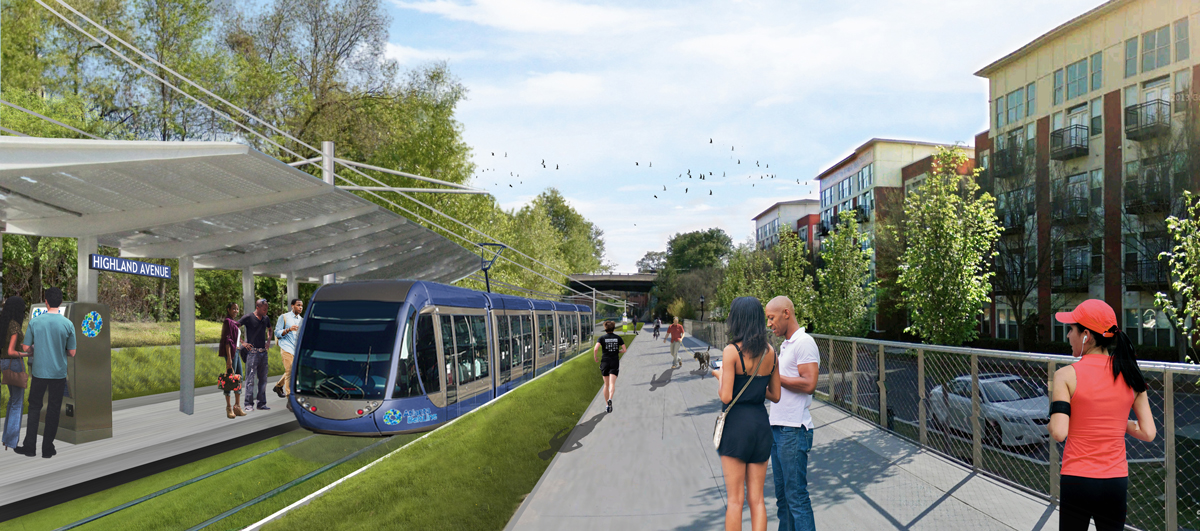
Rendering courtesy of Atlanta BeltLine
When city and transit officials lobbied voters in 2016 to approve an additional sales tax to fund transit, they painted a picture of a truly connected Atlanta. Picture, they said, new rail lines, bus-rapid transit routes, infill MARTA stations. And the piece de resistance? Light-rail along the entire 22-mile loop of the Atlanta BeltLine, with spurs jutting from BeltLine nodes into the urban core, where they would connect with MARTA stations.
Of course, the promises came with a disclaimer: the roughly $2.5 billion generated by the 0.5 percent sales tax over 40 years could pay for only so much. The list of wants totaled nearly five times the amount of available funding. Federal and private funding, plus some cash from the state, would have to fund the rest. Others might be put on a waiting list or forgotten altogether.
Now, with the dollars rolling in, city and MARTA officials are having to prioritize their wish list. And to the dismay of the BeltLine’s creator, Ryan Gravel, it’s looking like light rail along the loop may be sacrificed on the altar of expediency and cost. That uncertainty is making transit advocates uneasy. Light rail has always been the capstone of the BeltLine.
Below, we break down what’s happening right now with transit along the BeltLine.
Where do things stand with the 0.5-percent sales tax funding?
Right now city, BeltLine, and MARTA staff are trying to decide how the bulk of the cash should be spent and are gauging what combination of projects would offer the biggest return on investment. With limited budgets in mind (plus high-dollar, well-supported routes like new light rail between Emory University and Lindbergh on the list), some transit officials and civic leaders are wondering whether the BeltLine (the full 22-mile loop or portions of it) will get crowded out from the funding pot. And light rail is expensive: Ben Limmer, MARTA’s assistant general manager, says light rail projects he oversaw in Arizona used to cost $70 million a mile; now the cost is almost double that. To build on the cheap, there’s the idea of adding bus-rapid transit rather than light rail. Also for debate: whether the city should skip the idea of transit altogether on the BeltLine and let the project continue solely as a trail-and-park amenity.
Wait, what’s “bus-rapid transit”?
Super fancy bus service, often with extended vehicles, traveling in its own lane so it bypasses other motorists. Because there are no tracks involved, routes can sometimes be tweaked, and the cost of reducing headways if ridership drops.
Do we need transit on the Beltline?
To the urban designer who dreamed up the project as a graduate student at Georgia Tech—a proposal borne with the vision of transit—absolutely.
“Transit makes the BeltLine for everyone,” Gravel says in a text message. “Every community and every person, rain or shine, at every time of day, and in every season. That’s the kind of Atlanta we want—and that’s the vision that has brought the BeltLine this far. But without urgent investment in transit, it will become what everyone fears—a beautiful greenway flanked by gentrified neighborhoods for people who can afford the luxury of that choice. That’s not why we’ve been working so hard for the last 18 years. That’s not what we wanted—and not what we voted for.”
So is Gravel is the only one upset about this?
Not at all—he’s joined by an army of BeltLine advocates, including Cathy Woolard, the former City Council president whose draw to urban wonks and Eastside residents propelled her to a third-place finish in the most recent mayoral election, BeltLine booster Angel Poventud, and Grant Henry, owner of Sister Louisa’s Church of the Living Room and Ping-Pong Emporium.
The group is organizing an advocacy effort, mobilizing Atlantans under the umbrella of “BeltLine Transit Now” to demand just that. Earlier this month, the leaders of the effort and roughly 40 other people clasped mugs on the back porch of the Georgia Beer Garden in the Old Fourth Ward to focus on a single question: how do we press MARTA and city leaders to commit to rail on the BeltLine? After 45 minutes of discussion, the crowd broke into groups based on City Council districts, where they exchanged contact information, delegated responsibilities, and agreed to reconvene in two weeks. Two weeks later, at Monday Night Garage in West End along the BeltLine’s Westside Trail, the grassroots group, now numbering around 65 people, discussed additional next steps, ranging from a group logo design to contacting members of MARTA’s board. There’s a Facebook group, as well.
Woolard and Gravel have worked together on the BeltLine before, right?
Yep! The band is back together. In August 2001, Woolard, at the time an Atlanta City Councilwoman, championed the BeltLine vision proposed by Gravel, then a young urban designer and planner, and the two launched a grassroots public education campaign about the project.
Why are they concerned?
Time is of the essence, they argue. MARTA is working on finalizing what we can afford to build with the limited funding available. The BeltLine was a major selling point in the passage of the 40-year transit tax, and the opportunity for another funding source that could help build out the rail vision isn’t likely to come along soon. Plus, new developments that sprout adjacent to the BeltLine currently are outfitted with parking decks and lots—not exactly features that convince people to ditch their cars.

Are people really asking if we need transit on the Beltline?
People always have. But as the Eastside and Westside trails have come online, some people—often real-estate professionals or transplants who arrived in Atlanta after the initial BeltLine push—question whether a transit line is really necessary, desired, or even safe. Perhaps the BeltLine is a better as a pedestrian- and bicyclist-only trail, they argue.
Would buses, rather than rail, be all that bad?
Despite the MARTA board of directors agreeing in 2007 that light rail was the best mode of transportation on the BeltLine, some, including Mayor Keisha Lance Bottoms, argue that other (less costly) modes, like bus-rapid transit, should be considered.
“I know at one point there was a lot of talk of light rail connectivity along the Beltline,” Bottoms said during a press conference last week to announce the city’s purchase of a 4.5-mile rail segment in southeast Atlanta that will effectively complete three-fourths of the BeltLine’s route. “Over the past several years there have been other options that have come into play that will remain a consideration, whether it is [bus rapid transit] lines or whatever the options may be. And who knows, by the time we’re able to actually make that a reality, there might be hovering spacecraft available.” (She was making a joke.) Others have mentioned a system similar to the Plane Train at Hartsfield-Jackson International Airport, which is actually not a train, but a rubber-tired people mover.
But Gravel lays out the cons. First, the project’s design since the early 2000s has been centered on light rail transit. Unlike the downtown Streetcar, BeltLine light rail would not have to co-exist with traffic; the space needed to operate the vehicles was included in the purchase of the land—it’s the wide swath of flower- and grass-filled land just next to the Eastside Trail. In addition, high-quality BRT can cost more thanks to required space for driver error, which could require the reconstruction of bridges and tunnels.
What does MARTA think?
First, bus-rapid transit along the BeltLine is not currently on the list of projects MARTA, BeltLine, and city staffers are analyzing, according to Ben Limmer, MARTA’s assistant general manager (and who previously worked on transit at ABI, the nonprofit planning and developing the BeltLine). The list of projects presented to voters prior to the 2016 vote are the only options under review.
Staff is compiling the initial public feedback they collected after the tax passed and are adding technical analysis, such as ridership, potential cost, and availability of other funding sources. Limmer says there was strong demand for increased bus service and public support for BeltLine transit. Once staffers are finished putting together different funding scenarios, which includes potential assistance from federal and private sources, the options will be presented to the public this summer to determine which should move forward for consideration.
“What is the best way to serve the entire community?” Limmer says about expanding the city’s transit network. “A mix of buses, mini-buses, light rail in some parts? We don’t have the money to do everything, so how do we make the biggest bang for the buck? It’s a dialogue I’m excited to have.”
What ultimately decides this issue?
Money and politics. After MARTA gathers feedback from the public, the final decision on what actually gets on the priority list will likely take place in the fall, when MARTA’s board of directors, which includes three representatives appointed by the City of Atlanta, will vote and make the final judgment. They no doubt will be looking to Bottoms for guidance. Public sentiment can play a large role in determining that outcome. But there’s also the reality that another group—developers, university officials, business leaders, politicians—might be just as passionate as BeltLine supporters about their pet project making the cut.














